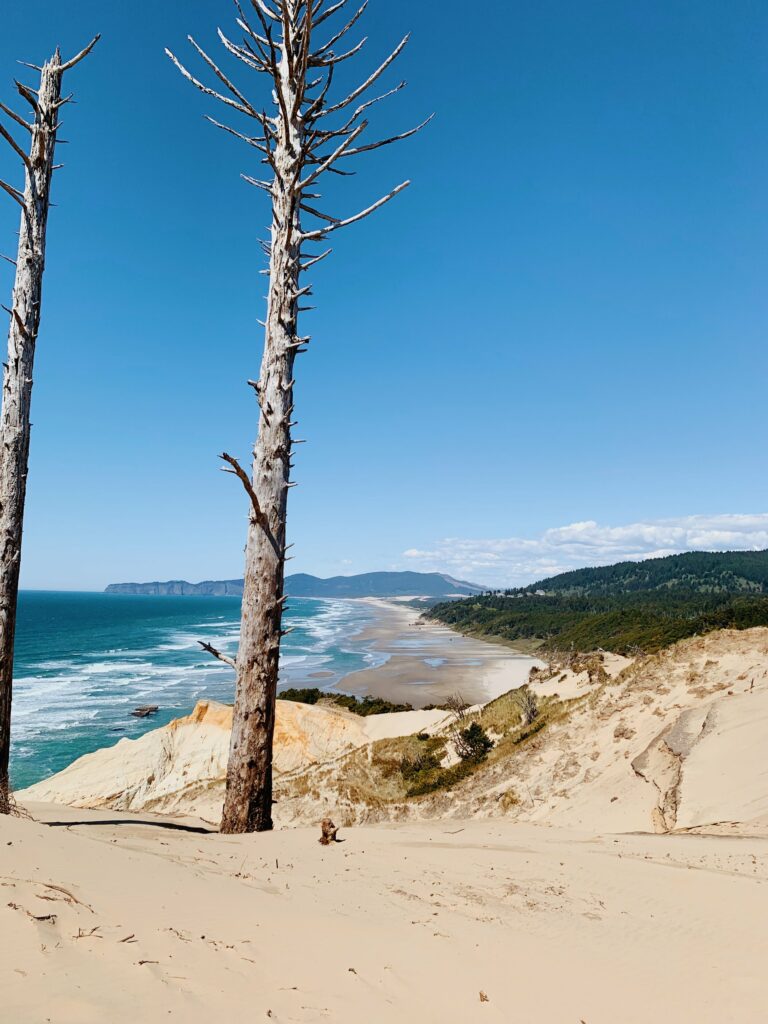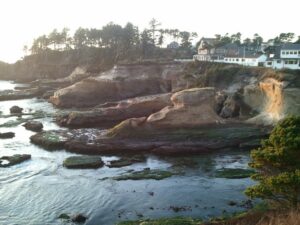By Karissa Courtney


Home brewing has become a big craze in the recent years, so this might be redundant if you are a brewer yourself, but we’re here to talk about all things beer! I was lucky enough to interview a brewer from Pelican Brewing in Pacific City, Buddy Pickett, and he enlightened me on the process, the ins-and-outs, and his personal experience.




The four main ingredients in beer are grain, water, hops, and yeast
The first step in the beer making process, is to build and design your recipe! The style of beer alters (obviously) the recipe! This figure shows some examples of the differences:

TOP FERMENTATION VS BOTTOM FERMENTATION
To start, Top vs Bottom fermentation is important. Top fermentation is the process of fermentation where the yeast settles on top of the liquid. This type of yeast has a higher tolerance to alcohol and ferments at higher temperatures compared to Bottom Fermenting yeasts. Some examples of top fermentation beers are: brown ales, pale ales, IPA’s, porters, stouts, wheats, and Belgian styles.
Bottom Fermentation happens with a different type of yeast that settles on the bottom after fermentation. It ferments more slowly and at lower temperatures compared to Top Fermenting yeasts. Examples of bottom fermentation beers: lagers and pilsners.
There is a third type of fermentation, called Spontaneous Fermentation, which is fermentation that happens with wild yeast and bacteria. An example of this types of beer: American sours.
HOW DO YOU ACTUALLY MAKE BEER?

GLOSSARY (BREWING HAS A LOT OF FUN WORDS):
ALPHA ACIDS – one of the two naturally occurring soft resins in hops. Alpha acids are converted during wort boiling to iso-alpha acids, which cause the majority of beer bitterness.
CONDITIONING PHASE – after initial fermentation in which the beer is matured or aged to prevent the formation of unwanted flavors and compounds.
GRIST – ground malt and grains ready for mashing
ISOMERIZATION – the chemical process that changes Alpha acids to iso-alpha acids
LAUTERING – the process of separating the sweet wort from the spent grains
LAUTER TUN – a large vessel with a false slotted bottom and a drain in which the mash is allowed to settle and sweet wort removed.
MASH – a mixture of ground malt (and possibly other grains) and hot water that forms the sweet wort after straining
MASH OUT – The process of raising the mash temperature to 170F. The goal is to halt any enzymatic activity and prevent further conversion of starches to sugars.
MASH TUN – the vessel in which grist is soaked in water and heated in order to convert the starch to sugar and to extract solubles from the grist
PITCHING – the addition of yeast to the wort once it has cooled down to desirable temperatures
PRIMARY FERMENTATION – the first stage of fermentation, lasting from 2-20 days, during which time the bulk of the fermentable sugars are converted to ethyl alcohol and CO2 gas.
SPARGE – in the lautering process, where the spent grains are sprayed with hot water to retrieve the liquid malt sugar and extract remaining in the grain husks.
TRUB – wort particles resulting from the precipitation of proteins, hop oils and tannins during the boiling and cooling stages of brewing.
TWO-ROW MALTED BARLEY – the oldest form of wild barley, which as two rows. It has a lower protein content compared to six-row barley, and thus has a higher fermentable sugar content. Malting happens when you let the barley sprout and then dry out quickly before germination.
VORLAUF – at the beginning of lautering and immediately before collecting the wort in the brew kettle, the recirculation of wort from the lauter tun are put back onto the top of the grain bed to clarify the wort.
WORT – the bittersweet sugar solution obtained by mashing the malt and boiling in the hops, which becomes beer through fermentation.
Depending on the style of beer you are making, you will use different malts. The base of beer is made up of a base malt, which is usually (for Buddy) two-row malted barley. It provides the necessary sugars needed in order for fermentation to occur and imparts a yellow color and a malt flavor. If two-row malted barley isn’t used, there are many specialty malts and brewing adjuncts (such as cereal grains) that can be used that greatly impact the beer’s flavor and color.
The first step in the actual brewing process is to hydrate the malted barley and create a mash. This is the process of mixing water and grain at a specific temperature to break down the starch into fermentable sugar. This will happen inside of the mash tun, or depending on the kind of system you are working on it may be a mash/lauter tun dual vessel. The mash must be mixed and stirred throughout the process. Mashing occurs at different temperatures (usually 140°F to 160°F) depending on the style of beer and fermentation profile being made. The mash will then rest for an hour or more to convert the starches into sugars. After the hour rest, you will mash out/off, where you reheat the mash back up to 170°F to lock in the fermentation profile and stop all enzymatic activity.
The second step is the lautering process, where the wort is extracted from the grain. This will happen in the lauter tun or mash/lauter tun. Before the wort is collected, recirculating/vorlauf has to happen to clarify the wort. Next, is the actual separating of the wort from the grain, also called run off. During the run off, sparging occurs, which is the act of running water over the grain bed to wash all the sugars down and extract the wort.
The third step is boiling. The wort is boiled at 212°F in a kettle for up to 90 minutes. During the boil, the wort is sterilized (killing any microbial organisms that may be present) and the unpleasant aromatic compounds present in the malt are boiled off. The wort is also concentrated as it boils down which can affect the sugar content or density of your wort, and will impact the overall alcohol content of the beer. The boiling step is also when hops are added to the kettle. Hops add bitterness and flavor to beer, and the earlier you add the hops, the more bitter the beer will be, due to the isomerization of the alpha acids present in hops.
The last step in the brewing process is to whirlpool. This is when the wort is spun rapidly, using centripetal force to separate hop matter and trub from the wort. You can add hops in the whirlpool as well which adds more aroma and flavor.
After this, the wort is cooled down rapidly and sent into the fermentation vessel. Yeast will be added as the cooled wort is being sent to the fermentation tank, or when the wort is already in the tank. From there, the yeast will consume the sugar and multiply, creating alcohol in the process.
In the fermentation vessel the beer goes through a primary fermentation phase where most of the sugars are are converted into alcohol, a conditioning phase where more hops can be added and the beer will be clarified and fully carbonated. For a standard ale, the entire fermentation process usually takes about two weeks, but the amount of time really depends on the type of beer being made. Once it has gone through all the necessary parameters, it is be ready for packaging in a bottle, can, or keg. (All info in this section by our good friend, Buddy the Brewer!)
WHAT’S IT LIKE BEING A BREWER AT PELICAN?
A BARREL OF BEER IS EQUAL TO ABOUT 330 12 OZ CANS OF BEER
From 2015 to 2019, Pelican Brewing Company tripled their production: going from roughly 10,000 barrels a year, to over 37,000 barrels a year. Currently, Pelican is on pace to brew 42,000 barrels in 2020. They are now going through a brew house expansion and upgrading their system from a five vessel 30 barrel brew house to a 90 barrel system. It will allow them to brew the same amount in two batches instead of six on their system now. Right now, they brew six batches a day, and usually brew every day (seven days per week).
Pelican’s production facility is located in Tillamook, Oregon where you can also visit their taproom. They have a couple of other brew pubs located up and down the coast, with their original location in Pacific City (where the company was founded) and their newest location in Cannon Beach.

The brewing team is limited to about 5-6 very talented individuals. It takes many more people to get beer out from start to finish though, including those that work in the cellar (for aging beer) and lab and those on the packaging/shipping/receiving team. Buddy said that everyone is incredibly hard working and flexible in this growing company.
There are two brewing shifts: a morning shift and an afternoon/evening shift. Currently, Buddy is on the morning shift, his day starting at 4 AM. The brew team will mill in their first batch of the day ahead of time so they can immediately mash their first batch when Buddy and fellow brewers arrive in the morning. Each batch follows two hours behind the last as it moves throughout the brew house in the various stages of the brewing process. Buddy will usually complete two batches from start to finish and the afternoon shift brewer will pick up in the middle of the day wherever the process is left off.
. . .
“The relationships I have created with the people I have worked with and the people I have met have added depth and joy to my life.”
Buddy started his brewing career in Bend, OR at Boneyard Beer (read more HERE if you’re in the area) when he was only 19 years old. He has now been a brewer for over 7 years and loves working at Pelican because it allows him to do what he loves (brew beer) in a place that he loves (the Oregon Coast). At Pelican, some of his favorite beers that he makes are the Tsunami Export Stout and the Pelicano Lager Cerveza, the latter of which he describes as “crisp and crushable”. He not only enjoys drinking them, but said that the processes of brewing them are unique and challenging. If you’re in the area, you should definitely give these ones a try!
He also has had the opportunities to brew some of his own recipes. He says, “every batch is an experiment and we are always playing around with recipes and different styles of beer.” Lately, they have been experimenting with a new strain of yeast that has just come on to the scene.
When asked, Buddy said that one of his favorite breweries is Beachcrest Brewing in Gleneden Beach. It is a small community brewpub run by his friends Matt and Amy. His other favorite coastal brewery is Yachats Brewing and Farmstore in Yachats. They source some of the best quality ingredients they can for their restaurant and brewery and have sustainable business practices. You will find both of these breweries in our list below!

NOW THAT YOU ARE A PROPER BEER CONNOISSEUR
Oregon boasts some of the best small breweries, and the Oregon Coast is no exception. If you’ve ever wanted to road trip the entire coastline of Oregon, we highly suggest it! And along the way you shouldn’t miss the best beers that Oregon has to offer. We will start as north as you can be (while still being in Oregon) and move our way south towards California.
***Remember to check the local laws and guidelines regarding Covid-19 when you are traveling***
NORTH
Fort George Brewery and Public House | 1483 Duane St, Astoria
Reach Break Brewing | 1343 Duane St, Astoria
Astoria Brewing Company | 144 11th St, Astoria
Buoy Beer Company | 1 8th St, Astoria
Seaside Brewing Company | 851 Broadway St, Seaside
Public Coast Brewing Company | 264 E 3rd St, Cannon Beach
de Garde Brewing | 114 Ivy Ave, Tillamook
Pelican Brewing (multiple locations, this is the main) | 33180 Cape Kiwanda Dr, Pacific City
Rusty Truck Brewing Company | 4649 SW Hwy 101, Lincoln City
Beachcrest Brewing Company | 7755 U.S. 101, Suite E5, Gleneden Beach
The Horn Public House and Brewery(Depoe Bay Brewing)| 110 SE N Coast Hwy, Depoe Bay
Bier One Brewing | 424 SW Coast Hwy, Newport
Newport Brewing Company | 1118 SW Canyon Way, Newport
Rogue Ales and Spirits | 2320 SE Marine Science Dr, Newport
Wolf Tree Brewery Taproom | 4590 SE Harborton St, Newport
Yachats Brewing and Farmstore | 348 US-101, Yachats
Homegrown Public House and Brewery | 294 Laurel St, Florence
7 Devils Brewing Co | 247 S 2nd St, Coos Bay
Bandon Brewing Company | 395 2nd St SE, Bandon
Gold Beach Brewing Company | 29975 Harbor Way, Gold Beach
Arch Rock Brewing Company | 28779 Hunter Creek Rd, Gold Beach
Chetco Brewing Company | 830 Railroad St, Brookings
Misty Mountain Brewing | 625 Chetco Ave, Brookings























SOUTH






